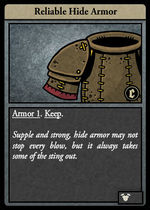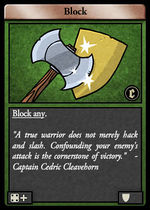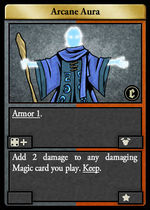Reactions and Traits
| Line 1: | Line 1: | ||
<p align="justify"> | <p align="justify"> | ||
| − | One of the most unique feature set of [http://www.cardhunter.com/ Card Hunter] lies in its reaction mechanics. In fact, it is so unique that the developer diaries contain three chapters ([http://www.cardhunter.com/2011/09/dev-diary-8/ Jon talks about reactions],[http://www.cardhunter.com/2011/09/dev-diary-9-reactions/ Skaff Elias talks about reactions],[http://www.cardhunter.com/2011/09/dev-diary-10-more-about-reactions/ developers talk about more reactions]) worth of explanations on the history, motivation and implementation. Readers are advised to browse the links for in-depth information and key insights. Another distinct gameplay feature revolves around the {{K|Trait}} mechanic. While card reactions provide a subtle way of streamlining gameplay flow, traits present more strategic deck building depth to the player. This guide presents some basics with regard to reactions and traits with examples of commonly encountered cards. Readers are advised to browse the [[Keywords]] guides for detailed information. | + | One of the most unique feature set of [http://www.cardhunter.com/ Card Hunter] lies in its reaction mechanics. In fact, it is so unique that the developer diaries contain three chapters ([http://www.cardhunter.com/2011/09/dev-diary-8/ Jon talks about reactions], [http://www.cardhunter.com/2011/09/dev-diary-9-reactions/ Skaff Elias talks about reactions], [http://www.cardhunter.com/2011/09/dev-diary-10-more-about-reactions/ developers talk about more reactions]) worth of explanations on the history, motivation and implementation. Readers are advised to browse the links for in-depth information and key insights. Another distinct gameplay feature revolves around the {{K|Trait}} mechanic. While card reactions provide a subtle way of streamlining gameplay flow, traits present more strategic deck building depth to the player. This guide presents some basics with regard to reactions and traits with examples of commonly encountered cards. Readers are advised to browse the [[Keywords]] guides for detailed information. |
</p> | </p> | ||
| Line 6: | Line 6: | ||
<p align="justify"> | <p align="justify"> | ||
A reaction consists of a trigger condition, trigger effect and a trigger result. A trigger condition refers to the state required for the reaction to manifest/activate. Trigger effect refers to the function of the reaction while the trigger result refers to the outcome of the reaction. As reactions are tied to actions/state of the game itself, bounded action space translates into bounded reaction types. There are currently 6 broad types of reactions. | A reaction consists of a trigger condition, trigger effect and a trigger result. A trigger condition refers to the state required for the reaction to manifest/activate. Trigger effect refers to the function of the reaction while the trigger result refers to the outcome of the reaction. As reactions are tied to actions/state of the game itself, bounded action space translates into bounded reaction types. There are currently 6 broad types of reactions. | ||
| − | + | </p> | |
{| class="chtable_b striped" style="margin-left: auto; margin-right: auto;" | {| class="chtable_b striped" style="margin-left: auto; margin-right: auto;" | ||
| Line 13: | Line 13: | ||
! Reaction !! Trigger condition !! Trigger effect !! Trigger result | ! Reaction !! Trigger condition !! Trigger effect !! Trigger result | ||
|- | |- | ||
| − | | Armor || Incoming damage + | + | | Armor || Incoming damage + die roll (optional) || Damage type damage reduction || Modified/unmodified damage value passed |
|- | |- | ||
| − | | Block || Incoming attack + | + | | Block || Incoming attack from front + die roll (optional) || Attack type negation || Modified/unmodified attack passed |
|- | |- | ||
| − | | Boost || Change in game state/action + | + | | Boost || Change in game state/action + die roll (optional) || Add/enhance game state/action || Apply additions/enhancement |
|- | |- | ||
| − | | Handicap || Change in game state/action + | + | | Handicap || Change in game state/action + die roll (optional) || Add negative state/action || Apply negative state |
|- | |- | ||
| − | | Move || Change in unit position + | + | | Move || Change in unit position + die roll (optional) || Modify movement range || Modified/unmodified value passed |
|- | |- | ||
| Special || Unique game state/action || Unique gameplay effect || Modified/unmodified effect passed | | Special || Unique game state/action || Unique gameplay effect || Modified/unmodified effect passed | ||
| + | |} | ||
| + | |||
| + | {| | ||
| + | | STYLE="vertical-align: center; text-align:justify;" align="left" | Figure 1 shows an example of a card with the {{K|Armor}} reaction: [[Cards/Reliable Hide Armor|Reliable Hide Armor]]. [[Cards/Reliable Hide Armor|Reliable Hide Armor]] is a common [[:Category:Armor_Card|armor]] card found in most low-level items. It reacts to incoming damage and reduces it by 1. As the die roll is 1+, [[Cards/Reliable Hide Armor|Reliable Hide Armor]] always mitigates incoming damage by 1 and is therefore an absolute damage reducer. Multiple [[Cards/Reliable Hide Armor|Reliable Hide Armors]] will stack the damage reduction as the reaction processes from the first to the next. <br /><br /> Figure 2 shows an example of a {{K|Block}} reaction: [[Cards/Block|Block]]. Unlike [[Cards/Reliable Hide Armor|Reliable Hide Armor]], the [[Cards/Block|block]] trigger effect uses the keyword {{K|Block Any|Block any}}. This means that the trigger effect will negate any type of attack from the front provided the trigger condition is satisfied. In this case, the trigger condition is an incoming frontal attack with a die roll greater than 4 in order for the {{K|Block Any|Block any}} effect to occur. Successful trigger result 'blocks' the attack. <br /><br /> Another common reaction is the Boost. There are many interpretations to the boost effect. In general, boosts are commonly used to increase or enhance an action/game state. Arcane aura (Fig. 3) is a classic example of a {{K|Boost|boost}} reaction. <br /><br /> <span style="color: yellow">'''IMPORTANT: All reactions are represented by a grey background.'''</span> | ||
| + | | [[File:Reliable Hide Armor.jpeg|thumb|150px|Fig. 1: An armor reaction card]] | ||
| + | | [[File:Block.jpeg|thumb|150px|Fig. 2: A block reaction card]] | ||
| + | | [[File:Arcane Aura.jpeg|thumb|150px|Fig. 3: A boost reaction card]] | ||
|} | |} | ||
| Line 32: | Line 39: | ||
<!-- | <!-- | ||
| − | |||
| − | |||
| − | |||
| − | |||
| − | |||
| − | |||
| − | |||
| − | |||
| − | |||
| − | |||
| − | |||
| − | |||
| − | |||
| − | |||
| − | |||
| − | |||
| − | |||
| − | |||
| − | |||
| − | |||
| − | |||
| − | |||
| − | |||
| − | |||
| − | |||
| − | |||
{| | {| | ||
Revision as of 21:46, 29 August 2013
One of the most unique feature set of Card Hunter lies in its reaction mechanics. In fact, it is so unique that the developer diaries contain three chapters (Jon talks about reactions, Skaff Elias talks about reactions, developers talk about more reactions) worth of explanations on the history, motivation and implementation. Readers are advised to browse the links for in-depth information and key insights. Another distinct gameplay feature revolves around the Trait mechanic. While card reactions provide a subtle way of streamlining gameplay flow, traits present more strategic deck building depth to the player. This guide presents some basics with regard to reactions and traits with examples of commonly encountered cards. Readers are advised to browse the Keywords guides for detailed information.
Reactions
A reaction consists of a trigger condition, trigger effect and a trigger result. A trigger condition refers to the state required for the reaction to manifest/activate. Trigger effect refers to the function of the reaction while the trigger result refers to the outcome of the reaction. As reactions are tied to actions/state of the game itself, bounded action space translates into bounded reaction types. There are currently 6 broad types of reactions.
| Reaction | Trigger condition | Trigger effect | Trigger result |
|---|---|---|---|
| Armor | Incoming damage + die roll (optional) | Damage type damage reduction | Modified/unmodified damage value passed |
| Block | Incoming attack from front + die roll (optional) | Attack type negation | Modified/unmodified attack passed |
| Boost | Change in game state/action + die roll (optional) | Add/enhance game state/action | Apply additions/enhancement |
| Handicap | Change in game state/action + die roll (optional) | Add negative state/action | Apply negative state |
| Move | Change in unit position + die roll (optional) | Modify movement range | Modified/unmodified value passed |
| Special | Unique game state/action | Unique gameplay effect | Modified/unmodified effect passed |
| Figure 1 shows an example of a card with the Armor reaction: Reliable Hide Armor. Reliable Hide Armor is a common armor card found in most low-level items. It reacts to incoming damage and reduces it by 1. As the die roll is 1+, Reliable Hide Armor always mitigates incoming damage by 1 and is therefore an absolute damage reducer. Multiple Reliable Hide Armors will stack the damage reduction as the reaction processes from the first to the next. Figure 2 shows an example of a Block reaction: Block. Unlike Reliable Hide Armor, the block trigger effect uses the keyword Block any. This means that the trigger effect will negate any type of attack from the front provided the trigger condition is satisfied. In this case, the trigger condition is an incoming frontal attack with a die roll greater than 4 in order for the Block any effect to occur. Successful trigger result 'blocks' the attack. Another common reaction is the Boost. There are many interpretations to the boost effect. In general, boosts are commonly used to increase or enhance an action/game state. Arcane aura (Fig. 3) is a classic example of a boost reaction. IMPORTANT: All reactions are represented by a grey background. |
Traits
Coming Soon !


